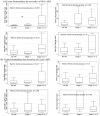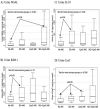Cystatin C in acute kidney injury diagnosis: early biomarker or alternative to serum creatinine?
- PMID: 25475610
- PMCID: PMC4372053
- DOI: 10.1007/s00467-014-2987-0
Cystatin C in acute kidney injury diagnosis: early biomarker or alternative to serum creatinine?
Abstract
Background: Early acute kidney injury (AKI) diagnosis is needed to pursue treatment trials. We evaluated cystatin C (CysC) as an early biomarker of serum creatinine (SCr)-AKI and an alternative to define AKI.
Methods: We studied 160 non-cardiac children in the intensive care unit (ICU). We measured daily CysC and SCr. AKI was staged by KDIGO (Kidney Disease: Improving Global Outcomes) guidelines using SCr and CysC (CysC-AKI). We calculated area under the curve (AUC) for (1) neutrophil gelatinase-associated lipocalin (NGAL), interleukin-18 (IL-18), kidney injury molecule-1 (KIM-1) and urine CysC to diagnose SCr- and CysC-AKI; and (2) for CysC to diagnose SCr-AKI. We evaluated AKI associations with length of stay and ventilation duration.
Results: We found that 44 % of patients developed SCr-AKI; 32 % developed CysC-AKI. Early ICU NGAL was most diagnostic of CysC-AKI (AUC 0.69, 95% CI 0.54-0.84); IL-18 was most diagnostic for SCr-AKI (AUC 0.69 95% CI 0.55-0.82). Combining SCr and CysC-AKI definition led to higher biomarker diagnostic AUC's. CysC-AKI was not more strongly associated with clinical outcomes. Early ICU CysC predicted SCr-AKI development (AUC 0.70, 95 % CI 0.53-0.89).
Conclusions: Our findings do not support replacing SCr by CysC to define AKI. Early ICU CysC predicts SCr-AKI development and combined SCr-CysC-AKI definition leads to stronger AKI biomarker associations.
Figures




Similar articles
-
Association of definition of acute kidney injury by cystatin C rise with biomarkers and clinical outcomes in children undergoing cardiac surgery.JAMA Pediatr. 2015 Jun;169(6):583-91. doi: 10.1001/jamapediatrics.2015.54. JAMA Pediatr. 2015. PMID: 25844892 Free PMC article.
-
Serum cystatin C for acute kidney injury evaluation in children treated with aminoglycosides.Pediatr Nephrol. 2017 Jan;32(1):163-171. doi: 10.1007/s00467-016-3450-1. Epub 2016 Oct 14. Pediatr Nephrol. 2017. PMID: 27743042 Free PMC article.
-
Cystatin C as an early marker of acute kidney injury and predictor of mortality in the intensive care unit after acute myocardial infarction.Arab J Nephrol Transplant. 2013 Jan;6(1):21-6. Arab J Nephrol Transplant. 2013. PMID: 23282229
-
Molecular markers for ischemia, do we have something better then creatinine and glomerular filtration rate?Arch Esp Urol. 2013 Jan-Feb;66(1):99-114. Arch Esp Urol. 2013. PMID: 23406805 Review.
-
Advances in acute kidney injury associated with cardiac surgery: the unfolding revolution in early detection.J Cardiothorac Vasc Anesth. 2012 Apr;26(2):340-5. doi: 10.1053/j.jvca.2012.01.001. J Cardiothorac Vasc Anesth. 2012. PMID: 22405191 Review.
Cited by
-
Preliminary investigation of the effect of non-cardiac surgery on intraoperative islet and renal function: a single-center prospective cohort study.Front Med (Lausanne). 2024 Feb 13;11:1235335. doi: 10.3389/fmed.2024.1235335. eCollection 2024. Front Med (Lausanne). 2024. PMID: 38414619 Free PMC article.
-
Cystatin C and α-1-Microglobulin Predict Severe Acute Kidney Injury in Patients with Hemorrhagic Fever with Renal Syndrome.Pathogens. 2020 Aug 18;9(8):666. doi: 10.3390/pathogens9080666. Pathogens. 2020. PMID: 32824680 Free PMC article.
-
Multi-Organ Dysfunction in Cerebral Palsy.Front Pediatr. 2021 Aug 9;9:668544. doi: 10.3389/fped.2021.668544. eCollection 2021. Front Pediatr. 2021. PMID: 34434904 Free PMC article. Review.
-
Perioperative Acute Kidney Injury: Risk Factors and Predictive Strategies.Crit Care Clin. 2017 Apr;33(2):379-396. doi: 10.1016/j.ccc.2016.12.008. Crit Care Clin. 2017. PMID: 28284301 Free PMC article. Review.
-
Metabolomics in Acute Kidney Injury: The Clinical Perspective.J Clin Med. 2023 Jun 16;12(12):4083. doi: 10.3390/jcm12124083. J Clin Med. 2023. PMID: 37373777 Free PMC article. Review.
References
-
- Nephrology ASo. American Society of Nephrology Renal Research Report. J Am Soc Nephrol. 2005;16:1886–1903. - PubMed
-
- Al-Ismaili Z, Palijan A, Zappitelli M. Biomarkers of acute kidney injury in children: discovery, evaluation, and clinical application. Pediatr Nephrol. 2011;26:29–40. - PubMed
-
- Devarajan P. Cellular and molecular derangements in acute tubular necrosis. Curr Opin Pediatr. 2005;17:193–199. - PubMed
Publication types
MeSH terms
Substances
Grants and funding
LinkOut - more resources
Full Text Sources
Other Literature Sources
Miscellaneous

